 Patrick
Rosenkranz, American publicist, movie expert and author of a
forthcoming book on the history of the movement of the "Underground Comix" of
the 60's and 70's in the USA and Europe, gave us gracefully permission to post
his chapter on the Dutch underground comix on our web-site.
Patrick
Rosenkranz, American publicist, movie expert and author of a
forthcoming book on the history of the movement of the "Underground Comix" of
the 60's and 70's in the USA and Europe, gave us gracefully permission to post
his chapter on the Dutch underground comix on our web-site.
You can reach the
author at : RosenPat@aol.com
COMIX in the
NETHERLANDS
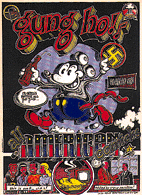 The Netherlands experienced a comix
movement that paralleled the American undergrounds, but with several cultural
differences.
The Netherlands experienced a comix
movement that paralleled the American undergrounds, but with several cultural
differences.
Although the Dutch underground comix were considered a part of
the counterculture, many of the cartoonists were as influenced by Donald Duck
comic books as they were by the American undergrounds, and also found
inspiration in architecture, music, and European art traditions.
Dutch
underground publications often took the form of tabloid newspapers and comic
books, but some alternate publications preferred to experiment with printing and
layout and binding techniques, and their publications changed size and
appearance with each issue.
When the early Zap Comics made their way to
Amsterdam bookstores in 1968, several Dutch members of the Underground Press
Syndicate traded subscriptions with their American counterparts, and kept their
readers abreast of the latest Furry Freak Brothers adventures.
The UPS free
exchange policies were used to justify several unauthorized reprints of
underground strips by publisher Steve Davidson including Om Homemade Comix and
Gung-Ho!
Real Free Press
In November 1968, the first issue of
Real Free Press Illustratie was published by Martin Bremmer and R. Olaf Stoop, a
former Provo pamphleteer.
Provos, the Dutch equivalent of hippies or Merry
Pranksters or Diggers, shared a common interest in sex, drugs, music, and
confronting the bastions of authority.
The Real Free Press was the "lost
connection for solid facts" according to Stoop, who ran the operation from a
hole in the wall shop on Oude Nieuwstraat in Amsterdam.
RFP also imported
American comics, and reprinted classic comic strips from Europe, Asia, and North
America, including Will Eisner's The Daily Spirit, Chao Hung and Chien
Hsiao-Tai's Monkey Subdues the White Bone-Demon, Gustave Verbeek's The
Incredible Upside Downs, and Wally Wood's Witzend.
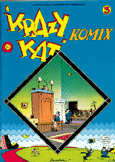 RFP Illustratie was a tabloid sized newspaper printed on white paper, with
whole pages of hand lettered text by Stoop, an labor of love that went above and
beyond what any other underground paper ever did.
RFP Illustratie was a tabloid sized newspaper printed on white paper, with
whole pages of hand lettered text by Stoop, an labor of love that went above and
beyond what any other underground paper ever did.
Six issues appeared between
1968 and 1974, loaded with comic strips and ads for other alternative
publications, from Horseshit to Nostalgia Press.
There were in-depth profiles
of Robert Crumb, Ron Cobb, S. Clay Wilson, Gilbert Shelton, Spain Rodriguez, as
well as articles on marijuana cooking, scientology, the Plaster Casters, Tijuana
Bibles, Vietnam oil fields, the history of matches, and an illustrated version
of Terry Southern's "Red Dirt Marijuana."
RFP also published two issues of
Wipe Out, a comic book in English, with Joost Swarte covers.Swarte also did
covers in the style of George Herriman for four issues of reprinted Krazy Kat
strips and one book of collected "Bringing Up Father" strips by George
McManus.
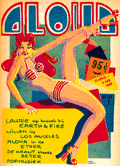 Tante Leny
Presenteert
Tante Leny
Presenteert
In 1968 Evert Geradts started drawing a funny animal comic strip called "De
Diertjes" for the weekly magazine Hitweek, which later changed its name to
Aloha, and became an underground newspaper.
Geradts, an avid collector of
American comics and jazz records, was inspired by Pogo and Donald Duck strips,
he said.
"I have always been a comics fan, but since 1968, when I started
making them myself, I devote almost all of my time to them. When the American
comix became known in Holland, we started a Dutch comic like that, which is
Tante Leny."
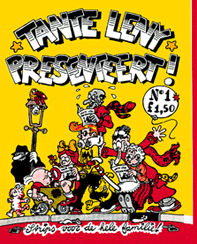 Several other Aloha
contributors, including Harry Buckinkx and Marc Smeets, were also invited to
contribute to Tante Leny Presenteert. Their first issue appeared in January
1971, and quickly sold out. They got right to work on the next issue, producing
six more before year's end.
Several other Aloha
contributors, including Harry Buckinkx and Marc Smeets, were also invited to
contribute to Tante Leny Presenteert. Their first issue appeared in January
1971, and quickly sold out. They got right to work on the next issue, producing
six more before year's end.
Geradts' wife, Leny Zwalve, was the namesake for
the comic book, but the invention of the Aunt Leny persona expressed a certain
Dutch sensibility, he said.
"We wanted to have a real cozy, comfy name,
because everything in Holland is like that. Life happens in the living rooms of
the family. Aunts are the limit of coziness, they remind you of thick friendly
women who visit you when your birthday is, give you presents and
candy."
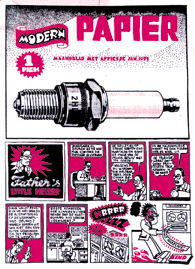 Another
homegrown comic appeared almost at the same time as TLP, called Modern Papier,
which was edited by art school dropout Joost Swarte.
Another
homegrown comic appeared almost at the same time as TLP, called Modern Papier,
which was edited by art school dropout Joost Swarte.
This comic book was
launched more as a personal showcase than to make money, said Swarte.
"I
decided to make my own platform as my comix production was bigger than the
demand."3
After he left the Academy of Industrial Design in Eindhoven in
1968, Swarte's work appeared in small magazines, including Uit de Kunst and De
Andere Krant.
In December, 1970 he and a group of like-minded artists began
publishing Modern Papier, producing ten issues before calling it quits in 1973.
Swarte started an 11th issue, but decided to merge it with the 13th issue of
Tante Leny Presenteert, which carries both covers, one inside the
other.
Swarte had been drawing comic strips for Tante Leny from the first
issue, even while he published Modern Papier, and Geradts had also done some
strips for Swarte's magazine.
Both men held jobs and took other assignments
while they laboriously produced pages and pages of intricate, innovative
artwork.
"I didn't consider it work," said Swarte. "It made me feel good and
brought me contacts with other comic artists with the same interests and
drive."4
Their sales potential was limited to a Dutch speaking
audience, so they were predestined to remain small. Sales in neighboring
countries was nearly non-existent. By comparison, the English reading market for
comic books was much bigger. Only a small handful of the Dutch cartoons were
ever reprinted in American underground publications.
"The Dutch underground scene was different from the American one," said
Swarte. "How can you categorize what Harry Buckinkx did or what Mark Smeets did?
Graphically, it was a hotchpotch in a distinctly European context. These people
were individualistic artists and we certainly stimulated each other. Seeing
other people's work in these magazines, yeah, that's encouraging. My contact
with Evert Geradts has been of great importance to me. Geradts was a comics fan,
he had a bookcase packed with comic books. When I started, I owned three
albums." Joost Swarte's diligence and talent speedily transformed his artwork
from goofy to gorgeous, perfecting a personal style of realistically rendered
cityscapes and stories of psychological fears coupled with trenchant social
satire. "Irony is part of my nature; it has always been there," said Swarte. "I
learned that I felt much more affinity with anarchic ideas, and that is
something that has never changed."5 He became widely admired for a clean and
clear art deco style, which became known the "Clear Line" method. Perspective
was suggested by placement of lines and planes in the picture, instead of by
shading.
Geradts' grasp of comics lore is evident in his work, which borrows its
rhythms from Carl Barks, its plasticity from Tex Avery and its lust for life
from Al Capp. His insightful, revealing stories about the enticements of love
use slapstick and sex as equal partners. Jan Zeiloor, a character with eerie
similarities to his creator, has a roller coaster relationship with Susie, who
alternately adores and torments him. His most breathtaking work used cartoons to
delve deep into the places many of us would rather not know about ourselves. In
TLP #18, the wackiness gets ugly, when a lynch mob mistakenly accuses Jan of
molesting and murdering children. As they go to work with knives and clubs,
Susie rides in on her bicycle to rescue him, but also falls victim to the
vigilantes. The story ends with their bloody bodies hanging from lamp posts. Two
issues later, we finally learn that they survived, but Jan has been permanently
transformed from a rubbery cartoon character.
The other regular artists in TLP included Art Clerkx, whose early work
eerily resembled Crumb, but soon evolved into his own style. Harry Buckinkx drew
highly detailed stories that starred Titul and Titula, siblings who inhabit a
landscape blending modern and medieval elements. Marc Smeets' pages were done as
sketchbooks rather than stories, peopled with characters as varied as Bronze Age
warriors to modern city dwellers. Bill Bodewes drew crudely humorous sex stories
about desperately horny women and impossibly endowed men, in a guilt free
cartoon land. Peter Pontiac, who got his start drawing rock and roll posters and
album covers, produced dark melodramas about sexual politics and drug addiction,
tempered with gallows humor and American slang. Another occasional contributor
was Willem, who was born in Holland as Bernard Holtrop, whose extreme depictions
of corruption and abuse of power made him one of the boldest critics in the
political arena.
In 1972, Robert Crumb, S. Clay Wilson, Kim Deitch, and Skip Williamson
joined the TLP crew, but only in reprint. "Our Dutch importers only did business
with distributors that handled Crumb's stuff, and very little else," said
Geradts. "Because of my contacts with Jay Lynch and Denis Kitchen I was able to
print Crumb's Homegrown Funnies and Bijou #6. Anything with Crumb in it is a
sure success, and anything without it will surely sell slowly. That's why we are
going to push Tante Leny a little by printing Crumb's "Jumping Jack Flash" in
#8."6 Following the example set by Bijou Funnies, TLP also began to carry ads
for other Dutch publishers and importers of American undergrounds, as well as
fan publications about comics, like Spruit, Inkt, and
Stripschrift.
Geradts and Zwalve, who were publishing Tante Leny from a
corner of their living room, thought that including American underground strips
might help boost their circulation, which hovered around 2000 copies. "A lot of
Dutch comix fans think that any U.S. comic is better than any Dutch comic, so we
always have to hear, ‘It's funny, but Crumb is better,' which we can't deny.
Crumb is indeed the greatest. Dutch people in general are really
anti-chauvinistic. There is even a proverb that goes, ‘Things coming from far
away are delicious.'"7 Turning the expression around, Geradts began shipping his
artwork to America, and his strips appeared in Projunior, Felch, and in six
issues of Snarf, including the cover for Snarf #4.
Tante Leny was a not for profit artist collective, and paid only a
small stipend to the contributors of each issue. Most of the revenues were
reinvested in production costs, like high quality paper stock and color
separations. The printer explained to the editors that he could print eight
pages at a time on two sides of a large sheet of paper, so that three sheets of
paper would give them a 24 page comic book. Then they could print the color
covers two at a time on a sheet of slick paper, with black only on the back
side. For a little more money, they could print four different color pages on
slick paper and then insert the second color page inside the comic and have a 32
page book. For issues #12 and #13 in 1973, Geradts created three color covers,
using the three process colors but no black. TLP #19 started the switch to a
larger format, with a tall thin book that told four stories
simultaneously.
After he retired Modern Papier, Swarte has hired to edit an album sized
magazine of Dutch and French artists called Cocktail Comix for Tango, a
publisher who would, it was hoped, turn Dutch comix into a paying proposition.
Only one issue was published, however, and Tango also abandoned its plans to
publish anthologies of eight American underground cartoonists.
In November, 1975 the Rotterdamse Kunststichting mounted an
exhibition of comic art. Work by ten Tante Leny artists made up the show, which
ran for a month. Each artist was given an option to create a room-sized, three
dimensional space to display their work. Some chose rectangles, but other
configurations included an Arabian oasis, a nomad's tent, a camper and giant
sketch book. Video monitors showed the history of the magazine and its
contributors, and large paintings lined the windows above the museum's entrance.
The comic strip fanzine Inkt did a catalog of the exhibit, which was given to
visitors, and a deluxe, large size, color comic edition, Tante Leny Presenteert
#20 was published for this occasion. The art didn't stop at the display walls,
as there was production work going on during the show. The magazine Furore put
out their first issue from a functioning office in Art Clerkx' display space.
Leny Zvalve reproduced the entire TLP office space from her home in Den Haag,
which is actually only part of one room, but it was transported and reassembled
in exact detail to the Rotterdam museum.
"It was a big success," said Zvalve. "Everyone could come in for free there.
It was near a lot of shopping centers. There were a lot of little boys and
fathers and mothers and old ladies --- everybody came."
"It drew more visitors than any other exhibition they had up to that time,"
added Geradts.
By the mid-1970s, the comix movement had slowed down in Europe as well as
America, and the publication schedule for Tante Leny became more sporadic. After
the 25th issue was published in 1978, the cartoonists called it quits. Geradts
then edited two issues of Talent, a large format comic magazine similar to the
American Arcade, which included letters to the editor, articles and interviews,
as well as comic stories. "I guess all the old TLP artists go through the same
malaise these years," said Geradts. "You know, the questions: ‘Must this go on
forever?' ‘Shall I switch to commercial art?' ‘Where is my youthful naivete?'
and so on, and so on. I'm trying not to think too much about these things,
because the only thing they'll do for you is kill your creativity.8 The French
publisher Artefact published an album, Reves de Grandeur in 1979 that collected
Geradts' "Jan Zeiloor" stories, as well as two albums of Tante Leny
Presente.
Swarte also broadened his horizons, moving from comic strips to commercial
and industrial design projects. "The world of comics is far too isolated, too
closed," he said. "People actually spend a lot of time navel-gazing. When you
ask a comic artist what his sources of inspiration are, he is often going to
name other comic artists. But take a look at Impressionism and Romanticism, or
at Dadaism and Surrealism -- they existed in music, in painting, in literature.
The thing is, as an artist, sure, you are on the lookout for kindred souls. But
it really doesn't matter which field of art you‘re working in. Within the world
of comics, things are different, though. Comic artists stick together, they hang
out together all the time, as if there were no common ground between comics and
visual art, literature and film. I think that's a mistake. You ought to move in
all directions, get yourself out into the world."9
His work now included
comics for children, wine labels, record covers, posters, shopping bags,
magazine covers, furniture, and garbage trucks. He began producing a two panel
strip for Vrij Nederland (Free Netherlands) in 1977, called "Niet Zo, Maar Zo"
(Not This Way, But That Way). He did commissions for personalized bookplates,
and made a set of comic strip commemorative stamps for the Dutch postal service,
PTT in 1984. Six of his stories from the French magazine Charlie were translated
into English and collected in a comic album, Modern Art, by Real Free Press.
Futuropolis also published several collections of Swarte art, including Swarte
Hors Serie in 1985 and Le Tour du Monde de Ric et Clair in 1988.
In 1982, Gilbert Shelton reprinted some of the Dutch comic strips in Rip Off
Comix #11 and asked Geradts to write an introduction to the work. "Everybody has
a lot of worries these years and young people think that it will always be like
this, or worse, and they paint on their clothes that they have no fun and even
that there is no future at all. So every time they see a hippie in the street
they spit on his sandals, as they think the hippies have stolen all the fun and
the future. The young people think this because the hippies are always smiling
so they must have more fun than other people. Of course young people do not know
that these hippies smile because they remember the comix from the sixties and
the seventies, where the characters used bad language and fucked and died with
much blood and had no morals at all, which made the readers laugh very loud."10
 Patrick
Rosenkranz, American publicist, movie expert and author of a
forthcoming book on the history of the movement of the "Underground Comix" of
the 60's and 70's in the USA and Europe, gave us gracefully permission to post
his chapter on the Dutch underground comix on our web-site.
Patrick
Rosenkranz, American publicist, movie expert and author of a
forthcoming book on the history of the movement of the "Underground Comix" of
the 60's and 70's in the USA and Europe, gave us gracefully permission to post
his chapter on the Dutch underground comix on our web-site. The Netherlands experienced a comix
movement that paralleled the American undergrounds, but with several cultural
differences.
The Netherlands experienced a comix
movement that paralleled the American undergrounds, but with several cultural
differences. RFP Illustratie was a tabloid sized newspaper printed on white paper, with
whole pages of hand lettered text by Stoop, an labor of love that went above and
beyond what any other underground paper ever did.
RFP Illustratie was a tabloid sized newspaper printed on white paper, with
whole pages of hand lettered text by Stoop, an labor of love that went above and
beyond what any other underground paper ever did. Tante Leny
Presenteert
Tante Leny
Presenteert Several other Aloha
contributors, including Harry Buckinkx and Marc Smeets, were also invited to
contribute to Tante Leny Presenteert. Their first issue appeared in January
1971, and quickly sold out. They got right to work on the next issue, producing
six more before year's end.
Several other Aloha
contributors, including Harry Buckinkx and Marc Smeets, were also invited to
contribute to Tante Leny Presenteert. Their first issue appeared in January
1971, and quickly sold out. They got right to work on the next issue, producing
six more before year's end. Another
homegrown comic appeared almost at the same time as TLP, called Modern Papier,
which was edited by art school dropout Joost Swarte.
Another
homegrown comic appeared almost at the same time as TLP, called Modern Papier,
which was edited by art school dropout Joost Swarte.